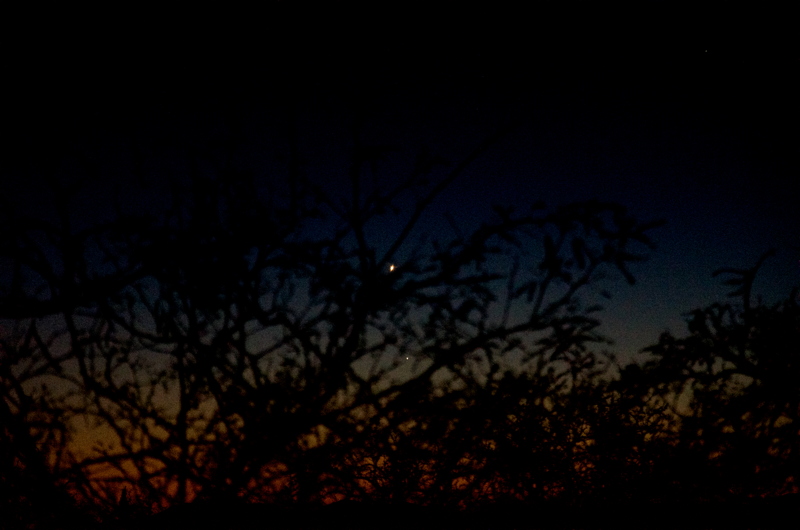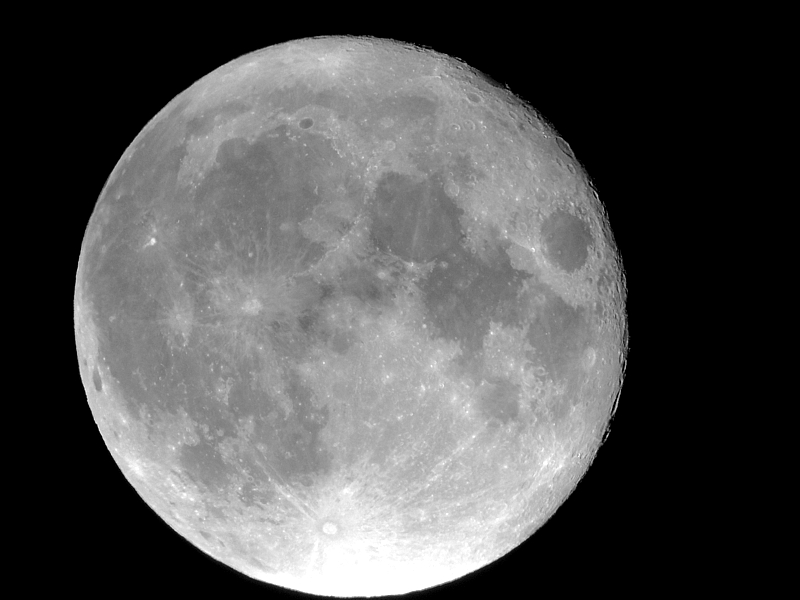Venus/Mercury Conjunction, Orion and Comet Lovejoy
Posted: 6 January 2015
|
Open: Monday, 5 January 2015, 1816 MST Temperature: 56°F |
Session: 765 Conditions: Clear, breezy |
1822 MST: viewed Mercury and then Venus, 83X. Both were low in the western sky and in a tree, as seen in this D7000 DSLR photo taken from inside the observatory, f/5.6, 1/10sec, ISO 1250, 105mm:

1834 MST: the eastern sky was beginning to brighten from the rising 1 day past Full moon. 1837 MST: viewed Venus and Mercury using 12x70 binoculars. They were colorful being so low in the sky.
1838 MST: began scanning the sky near Orion using my naked eyes to try to see Comet C/2014 Q2 (Lovejoy) before the sky got any brighter. After two minutes of scanning I finally picked it up with the naked eye as a faint object that was barely visible against a somewhat bright sky (rising moon and astronomical twilight that had not quite ended yet). The comet looked good in the 12x70 binoculars with a large coma visible.
1848 MST: I manually slewed the 8" telescope to the comet instead of doing a GOTO its RA/Dec coordinates. First, I aligned the telescope OTA visually to the comet, which was still barely visible. That put the comet in the field-of-view of the 7x50 finderscope on the telescope. I centered the comet in the finderscope and then viewed Comet Lovejoy at 83X in the 8" LX200-ACF. The coma was large. The nucleus was very bright and appeared star-like.
Next, I placed my D7000 DSLR on my POD Roller Desk and used my Project Nightflight knit cap to raise the lens. I aimed the camera towards the constellation of Orion and the Comet. The comet was not visible in the camera viewfinder. Began taking photographs of the sky using various exposure settings. This photo was taken at 1904 MST, f/4.2, 10 seconds, ISO 2500, focal length 34mm:

Mouseover or tap on image for labels
1904 MST: the bright moon was now rising over the hill to the east. Ended comet imaging. Resumed comet observing in the 8" telescope, first using 83X. Then switched to 222X and began monitoring the comet to detect its motion. The background stars allowed me to easily detect motion in 3 minutes. Continued to observe the comet, 222X. 1924 MST: switched back to 83X; the comet's coma seemed to be slightly elongated. Perhaps a hint of a tail? The pattern of the background stars allowed comet motion to be seen in about 5 minutes. 1930 MST: tried to see comet with the naked eye; no luck.
1950 MST: our house guest came out the observatory. First I introduced him to the SkyShed POD observatory and how it was made and assembled. He then got to view some objects: Comet Lovejoy (83X), the planet Uranus (222X), M42 (Orion Nebula, 83X), and the moon (83X with moon filter, 222X). I allowed him to use the handcontroller to slew around the moon to enjoy the various sights at 222X.
2030 MST: I did a quick demonstration of how easy it is to take a photograph of the moon through a telescope using a smartphone (or point-n-shoot camera). I handheld my iPhone 5s over the 24mm UWA eyepiece for this afocal 83X photo:

We then ended the session.
|
Close: Monday, 5 January 2015, 2049 MST Temperature: 53°F |
|
Comments are welcome using Email. If you are on Twitter you can use the button below to tweet this report to your followers. Thanks.
Cassiopeia Observatory Home Page
Copyright ©2015 Michael L. Weasner / mweasner@me.com
URL = http://www.weasner.com/co/Reports/2015/01/06/index.html
